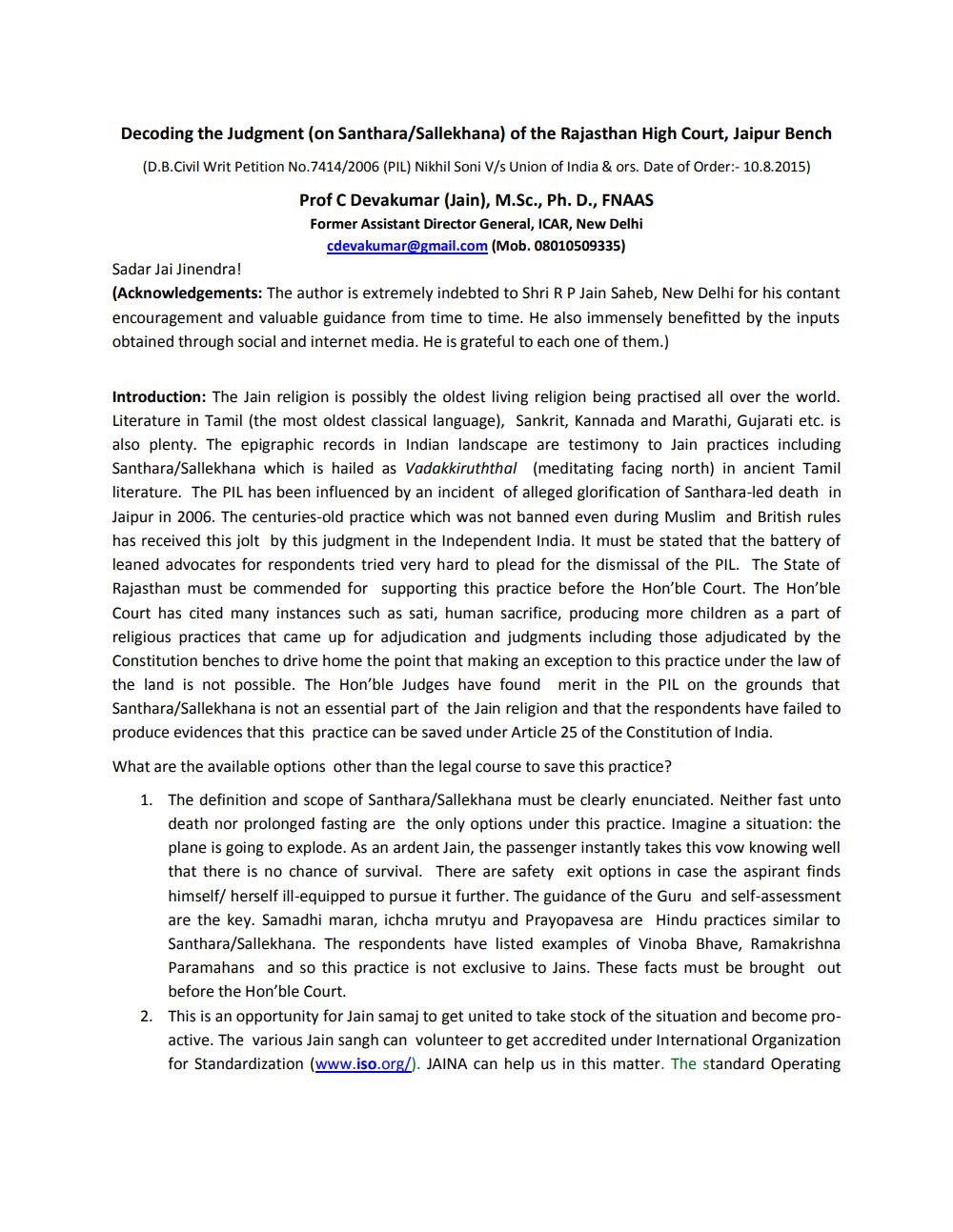________________
Decoding the Judgment (on Santhara/Sallekhana) of the Rajasthan High Court, Jaipur Bench
(D.B.Civil Writ Petition No.7414/2006 (PIL) Nikhil Soni V/s Union of India & ors. Date of Order:- 10.8.2015)
Prof Devakumar (Jain), M.Sc., Ph.D., FNAAS Former Assistant Director General, ICAR, New Delhi
cdevakumar@gmail.com (Mob. 08010509335) Sadar Jai Jinendra! (Acknowledgements: The author is extremely indebted to Shri R P Jain Saheb, New Delhi for his contant encouragement and valuable guidance from time to time. He also immensely benefitted by the inputs obtained through social and internet media. He is grateful to each one of them.)
Introduction: The Jain religion is possibly the oldest living religion being practised all over the world. Literature in Tamil (the most oldest classical language), Sankrit, Kannada and Marathi, Gujarati etc. is also plenty. The epigraphic records in Indian landscape are testimony to Jain practices including Santhara/Sallekhana which is hailed as Vadakkiruththal (meditating facing north) in ancient Tamil literature. The PIL has been influenced by an incident of alleged glorification of Santhara-led death in Jaipur in 2006. The centuries-old practice which was not banned even during Muslim and British rules has received this jolt by this judgment in the Independent India. It must be stated that the battery of leaned advocates for respondents tried very hard to plead for the dismissal of the PIL. The State of Rajasthan must be commended for supporting this practice before the Hon'ble Court. The Hon'ble Court has cited many instances such as sati, human sacrifice, producing more children as a part of religious practices that came up for adjudication and judgments including those adjudicated by the Constitution benches to drive home the point that making an exception to this practice under the law of the land is not possible. The Hon'ble Judges have found merit in the PIL on the grounds that Santhara/Sallekhana is not an essential part of the Jain religion and that the respondents have failed to produce evidences that this practice can be saved under Article 25 of the Constitution of India.
What are the available options other than the legal course to save this practice?
1. The definition and scope of Santhara/Sallekhana must be clearly enunciated. Neither fast unto
death nor prolonged fasting are the only options under this practice. Imagine a situation: the plane is going to explode. As an ardent Jain, the passenger instantly takes this vow knowing well that there is no chance of survival. There are safety exit options in case the aspirant finds himself/ herself ill-equipped to pursue it further. The guidance of the Guru and self-assessment are the key. Samadhi maran, ichcha mrutyu and Prayopavesa are Hindu practices similar to Santhara/Sallekhana. The respondents have listed examples of Vinoba Bhave, Ramakrishna Paramahans and so this practice is not exclusive to Jains. These facts must be brought out before the Hon'ble Court. This is an opportunity for Jain samaj to get united to take stock of the situation and become proactive. The various Jain sangh can volunteer to get accredited under International Organization for Standardization (www.iso.org/). JAINA can help us in this matter. The standard Operating




